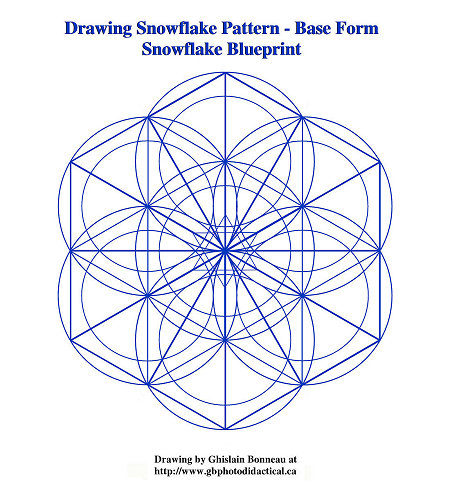
80 SNOWFLAKE PHOTOS PLUS DRAWINGS OF SNOWFLAKES BASE GEOMETRY DECODED
The Drawings I produced here are all copyright images from Ghislain Bonneau at gbphotodidactical.ca They can only be used as a reference and for Education or for drawing and coloring them on your computer for your own Elevation. The Base forms can also be used as a starting point to make your own Drawings designs. My Drawings of the base form of Snowflakes are NOT to be used in books, Magazines, or any other publications or on a Web page without my explicit written permission.
All Snow Flakes Photos on this page are from SnowCrystals.com and I have the permission to use them as long as I mention that I took them from their website.
I did crank up the resolution a bit and adjusted the clarity of those images and sometime I adjusted the saturation and contrast, and I also straighten some of the snowflakes and re-sized all images so that they would be all the same size on my website.
The owner of the Copyright at SnowCrystals.com is
(Kenneth Libbrecht)
Kenneth G. Libbrecht is a Professor of Physics at the California Institute of Technology (Caltech). A North Dakota native, Ken studies the molecular dynamics of crystal growth, including how ice crystals grow from water vapor, which is essentially the physics of snowflakes. He has authored several BOOKS on this topic, including The Snowflake: Winter’s Frozen Artistry, The Secret Life of a Snowflake, The Art of the Snowflake, and Ken Libbrecht’s Field Guide to Snowflakes.
He can be reached at kgl@caltech.edu
* * * * * * * * * * * * *
Like crop circles the base geometry that compose Snow Flakes are quite amazing in a sense that it is nature that creates them and their shape and size depends on many factors like, Temperature, Humidity, Wind, Air density, Altitude and so on. Most of their designs have things in common, like they are mostly made from Hexagon patterns and 6 fold geometry. The difference in their details and complexity vary greatly since that there is never one snowflake alike and their never will be one either, they are all different from one another. There is actually about 84 different TYPES of snowflakes and you can see some of them in this TABLE and the Snow Flakes Morphology Diagram below from SnowCrystals.com
In my drawings I tried to dismantle their basic geometry to show you how they are formed and when you will see the geometry involved in their formations, you will find them as amazing as I do for sure.
Most snowflakes are very symmetrical since that all branches where formed in the same weather conditions and at the same time, but there could be some difference between the elements of each branches in the same Snowflake. But what about their design ? Later on by drawing them I tried to understand more of their magnificent complexity, and what causes them to be so symmetrical and so I tried to find out what they are all about. I am still searching the answers to that but I think that it has something to do with magnetism at the quantum level, because in a water molecules you have 2 Atoms of Hydrogen that are Positively charged and 1 Atom of Oxygen that is Negatively Charged. So I think that when the water molecule reaches the freezing point that they always reacts the same way and therefore their branches are spreading in the same manner or patterns of the Atoms. So the resulting snowflake has always a basic Hexagon patterns and 6 fold geometry. The great variety and diversity of their forms like I said above depends on the weather conditions at the moment they where formed. So their only similarity and that is common to most of them is only present in the Hexagon patterns and 6 fold geometry, and the rest of their patterns is caused directly by how fast they where formed and are only different because of the different atmospheric conditions present at the time of their formations. See my basic geometry drawing of the SnowFlakes in action below those beautiful images.
More information about Snow Flakes can be found at SnowCrystals.com
ENJOY and SHARE............. Ghislain.
Click on the Icons to Open a Higher Resolution Image & Download
What do you see when you look at this Drawing?
Probably just Lines and Shapes, Me I see the Blueprint Image of the Quantum Magnetic Mechanics at work. It represents the movement of atoms and Protons and Electrons and Magnetic lines formed by their Attractions and Repulsion. It REPRESENT Exactly how a snow flake is formed. It is a VIEW in the inner workings of the Quantum Universe.
Very Cool isn't it ?
Enjoy and Share..........Ghislain.
Copyright © All rights reserved, to gbphotodidactical.ca and SnowCrystals.com


